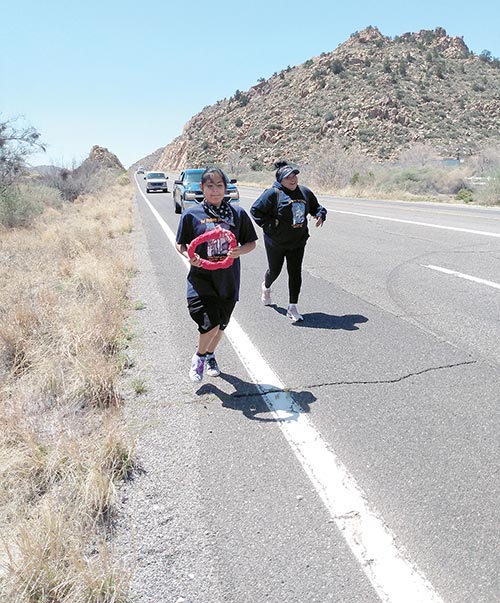
Hualapai prayer runners remember ancestors
By Sararesa Hopkins
Special to the Times
PEACH SPRINGS, Ariz.
Raeanna Smith, a Peach Springs Elementary School paraprofessional, ran this year’s La Paz Trail of Tears Run on April 21 because she wanted to bring her Hualapai ancestors home to Hákđugwi:v.
Hákđugwi:v is “Peach Springs” in the Hualapai language.

Special to the Times | Sararesa Hopkins
Young people participate in this year’s La Paz Prayer of Tears Run on April 21 running towards Peach Springs, Ariz.
Under cover of darkness at three o’clock in the morning, Smith, along with 44 Hualapai runners, gathered at the Hualapai Cultural Resources Center building to register, meditate and collect each runner’s commemorative black T-shirt and black sweatshirt.
At 3:28 a.m. the chilly winds swirl around the runners standing outside the building.
“It feels good to honor the people,” Allison Shongo said. “It’s kind of emotional…it’s been a while since I did this run.”
Shongo stood inside the CRC as the aroma of burnt sage enveloped the inside the building.
Outside under the inky early morning sky, five white vans and a dark colored van with the Hualapai Forestry decals were running. Later in the morning at 4:39 a.m., the vans full of runners traveled to Kingman’s Camp Beale Springs, also known as Fort Beale.
Camp Beale Springs/Fort Beale and Fort La Paz are tragic places where Hualapai ancestors were imprisoned from 1871 to 1873.
Removed from homelands
“From 1871 to ’73, the Pai Peoples were removed from their homelands and force-marched to two locations, Fort Beale and Fort La Paz, also known as Beale Springs and La Paz,” said Martina Dawley, director of the Hualapai Cultural Resource Department. “By the 1870s, white settlers began moving into Pai territory, which ultimately started the Hualapai Wars.”
Dawley, who is Navajo/Hualapai, explained that the Hualapai ancestors were subjected to abuse, neglect and death.
“They did not give up and in due course escaped on April 21, 1874,” she said. “They all went their different ways, including the Hualapai. The Pai People tried to return to their original bands’ homelands only to find that the white settlers occupied their lands.”
At 4:45 a.m., before the marathoners began their prayer run, they gathered in a circle and thought about their ancestors who fought hard to survive the La Paz Trail of Tears.
Grant “Junior” Tapija Jr., 93, stood with the assistance of his modern walker on wheels in the circle with two granddaughters, Calvina Putesoy and Roni Quasula.
“He’s one of the ones who knows (the) ‘La Paz,’ story,” Putesoy said, adding that Tapija is her great-great-grandfather. “He decided to (run La Paz) at the last minute.”
When Tapija runs the La Paz prayer run, he does not drink water.
“So that he can feel what our ancestors felt during their encampment and escape,” Dawley said. “His two lovely granddaughters, Roni Quasula and Calvina Putesoy, accompanied Mr. Tapija and both women stayed true to their grandfather’s tradition of no water.”
Putesoy who was dressed in a purple ribbon skirt, color-coordinated T-shirt and sacred protective red earth face paint, said she prepared for the La Paz prayer run by fasting.
“It’s something really powerful.,” she said. “I’m praying that this medicine (protective red earth face paint) brings me home.”
Standing by Tapija was his granddaughter, Quasula, who dressed similar to Putesoy with a ribbon skirt, color coordinated T-shirt and matching running shoes.
“It’s like my fifth or sixth time, running La Paz,” Quasula said. “I’m running for my people and my family.”
Invocation offered
Before the runners began their trek, Frank Mapatis, one of the Hualapai spiritual leaders, offered a heartfelt invocation. The other prayer run spiritual leaders were Jim Mahone and Jorigine Paya.
“There was a livelihood where our relatives were happy and all was good,” Mapatis said. “That was disrupted. Our ancestors went through that suffering. We are still here for a reason.”
Mapatis added that among the Hualapai people, they have experienced generational loss and grieving from the La Paz Trail of Tears.
“There’s an anger, we look to alcohol, money and all those things,” Mapatis said. “Until we get that peace with ourselves. My ancestors were beaten, they didn’t do anything wrong. Because we were different, (the Americans) were looking for water and a place to live, a new land, that we (were forcefully relocated to Fort Beale and Fort La Paz).”
When Mapatis finished, gourd shakers sounded and the group of runners gathered around Bird Singers who were present in the sacred gathering.
After the last Bird Song, the prayer runners began their spiritual trek to bring their ancestors home in Hákđugwi:v.
While running, 19-year-old Shaileen Gonzales liked the wind and the smell of the fresh air on her.
“For me, it’s more therapeutic,” said Gonzales, adding that she is an athlete in high school sports. “I feel very emotional for me (to commemorate the Hualapai ancestors).”
Bonita Imus, a Hualapai elder and culture teacher for Peach Springs Elementary School, taught her students the history of La Paz and the song that she wrote. Her students also painted La Paz pictorial flags on white fabric.
The Hualapai veterans helped Imus with that student project, and Imus organized the LaPaz student pictorial flags to be flown during the conclusion of the La Paz run.
‘You can feel it’
“You can feel it,” said Imus who dressed in a blue-colored traditional Hualapai ribbon dress and toted a backpack on her back. Imus held onto one of the student flagpoles as the blustery winds whisked the students’ flags.
“Your tears start coming,” she said. “They (the ancestors) are there with you.”
“I wanted to walk (in the end procession of the La Paz run) to show respect for my elders for what they went through,” said Lariah Havatone, a seventh-grade student. “It seems interesting with the stories that Ms. Imus shared with us (seventh grade class).”
Havatone marched with her culture teacher, Imus, and other classmates, Katie Victorino, seventh grade, and Domonick Crook, eighth grade, during the ending procession of the La Paz runners.
“It’s sad,” Victorino said as she held onto the flagpole that held the students’ La Paz flags. “We survived though.”
After completing the prayer run, the runners walked in a procession towards “downtown” Hákđugwi:v.
Peach Springs residents, Hualapai tribal members and employees and schoolchildren from Peach Springs Elementary School waited for the La Paz runners to return home.
Blustery winds continued to whip all the people waiting for the La Paz runners and when they did return, there was a joyous celebration with Bird Singers chanting the runners home like their ancestors.
The Hualapai people celebrated the commemorative remembrance of ancestors coming home in the heart of Hákđugwi:v.
“On April 21, 2022, after a two-year hiatus, the La Paz Trail of Tears Run took place,” said Dawley whose mother is from Chinle.
“Due to the COVID-19 pandemic, the run did not happen in 2020 and 2021,” she said. “2019 was the last run before the pandemic. 2020 would have marked the run’s fourth year, which have been the run from Ehrenberg, or La Paz, to Peach Springs.
“Instead of holding the four-year run to make up for it, we decided to move forward and continue the cycle of the run,” she said. “The four-year run is scheduled for the year 2024.
The Gamyu newsletter contributed to this story.








 Highway 264,
Highway 264, I-40, WB @ Winslow
I-40, WB @ Winslow